I was curious how the species of hardwood affects the taste of smoked pork. So I put together the best types of smoker wood and their flavor profiles:
The intensity of the smoked pork flavor can vary depending on factors such as the cut of wood, its age, and the amount of smoke exposure during the cooking process. It's always a good idea to experiment with different wood types to find the flavors that best suit your tastes.
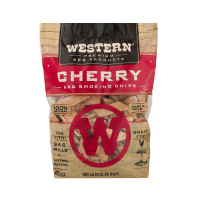 |
Cherry: Cherry wood gives a mild and slightly sweet flavor with a hint of tartness. Smoking cherry wood works well with poultry, pork, and fish. Cherry trees are found throughout the United States, but they are more common in the Midwest and Northeast regions. It takes 10 years or more for a cherry tree to reach full maturity in terms of size and fruit production. |
|
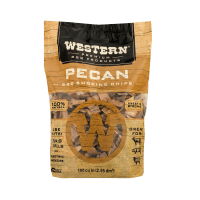 |
Pecan: Pecan wood offers a sweet and nutty flavor that is similar to hickory but milder. It's suitable for smoking various meats, including pork, poultry, and wild game. Pecan trees are most abundant in the southern United States, especially in states like Texas, Georgia, and Oklahoma. | |
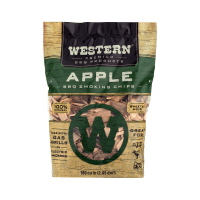 |
Apple: Apple wood offers a mild, sweet, and fruity flavor. Apple wood smoke pairs well with pork. Apple trees require a period of winter chill to break dormancy and set fruit. Some of the best apple trees are grown in Western New York (my hometown). |
|
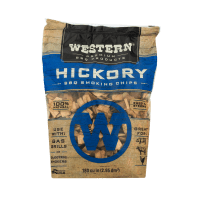 |
Hickory: Hickory wood is a popular choice for smoking, providing a strong, rich, and smoky flavor. Hickory smoke complements a wide range of meats, including pork, beef, and poultry. Hickory trees are predominantly found in the Southeastern United States, with a significant presence in states like Tennessee and North Carolina. |
|
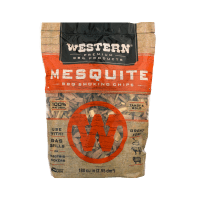 |
Mesquite: Mesquite wood is known for its bold, intense, and earthy flavor. It's often used to smoke beef, particularly in Texan-style barbecue. Mesquite trees are most commonly associated with Texas, particularly in the southwestern parts of the state. |
|
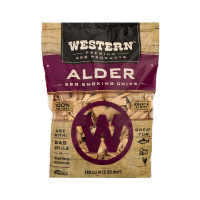 |
Alder: Alder wood is popular for smoking fish due to its light, slightly sweet, and delicate flavor. Alder wood is commonly used to smoke salmon. Alder trees are abundant in the Pacific Northwest, making them a popular choice for smoking fish in that region. |
|
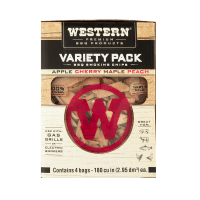 |
Mixed Variety: Apple, cherry, maple and peach wood. All four varieties are great for smoking pork, beef, fish, chicken, duck and vegetables. |
|
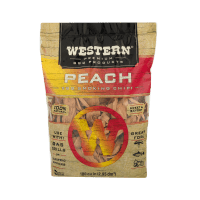 |
Peach: Peach wood offers a sweet and mild flavor that is similar to apple wood. Peach smoke works well with poultry, pork, and fish. Peach trees grow well in the Southeastern United States, including states like Georgia and South Carolina. |
|
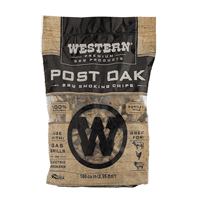 |
Post Oak: Oak wood provides a medium to heavy smoke flavor that is relatively subtle and versatile. Oak smoke pairs well with most meats and is often used in traditional barbecue. It's named "post oak" because its wood was historically used for making fence posts due to its durability and resistance to decay. It's native to the southeastern United States, particularly in Texas, Oklahoma, and surrounding regions. |
|
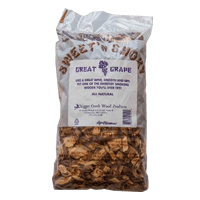 |
Grapevine: Grapevine wood provides a fruity and slightly sweet flavor. The smoke produced from grape wood pairs well with poultry, pork, and seafood. Grapevine wood chips are primarily from wine producing areas, such as New York State's Finger Lakes region. Grapevines can live for several decades. |
|
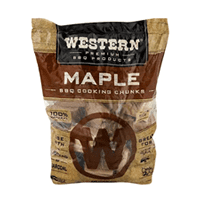 |
Maple: Maple wood gives a delicate and sweet flavor with a subtle smokiness. Maple smoke complements a range of meats, including pork, poultry, and vegetables. Maple trees vary in size, with heights ranging from 30 to 100+ feet or. They can live for hundreds of years under favorable conditions. |
The choice between pellets, chunks, logs, and charcoal depends on your preferences, equipment, and the flavor profile you wish to achieve.
Wood Pellets: Pellets are crafted from compressed hardwood sawdust and are available in a range of wood flavors like hickory, mesquite, cherry, and apple. In pellet smokers, you load the pellets into a hopper, set your desired temperature, and the smoker takes care of the rest. This method imparts a consistent and mild smoky flavor, making it ideal for beginners or those who prefer subtler smoke notes.
Wood Chunks: Chunks are larger pieces of hardwood, typically around the size of a fist. They come in various wood types and are favored by traditional smoking enthusiasts. Chunks provide more control over the intensity of the smoke, as you can adjust their placement and quantity in your smoker. The result is a more robust and complex smoky flavor than pellets due to the larger size and slower combustion.
Wood Logs: Logs represent the largest and least processed option. They are whole logs split into manageable sizes. Logs require a higher skill level, as they burn hotter and can be challenging to control, especially in smaller smokers. They are often employed in large offset smokers or smokehouses. Logs create a bold, intense smoke flavor. They are favored by experienced pitmasters for their ability to produce long-lasting smokes.
Charcoal: Charcoal is produced by heating wood in a low-oxygen environment until it carbonizes. Lump charcoal, in particular, is favored for smoking because it lacks additives. Charcoal is versatile and can be used for both grilling and smoking. When using charcoal for smoking, you can add wood chunks or chips to the coals to infuse your meat with smoke flavor. Charcoal itself primarily provides heat rather than a strong, smoky flavor.
The temperature range at which wood produces smoke is important for infusing flavor to the food you are cooking. In barbecue terminology, this is often called "smoking temperature" or "smoke point." Most wood will emit smoke when it reaches a temperature from 570°F to 750°F. According to ScienceDirect, the best smoke flavor is generated by hardwood embers that have an average temperature between 650°F and 750°F.
When using wood for smoking in a BBQ, you'll want to ensure that the wood is producing a consistent stream of thin, blueish smoke.
Note, you should AVOID smoking meat with softer wood like pine.
Patrick's
BBQ tips:
Try different rubs and BBQ sauces! Use a dry rub to enhance
the outer texture and flavor of your pork, or a marinade to deeply infuse flavors
deeper into the meat. Both methods have advantages and are often
combined for maximum flavor impact in pork dishes.
Part of the fun of cooking is experimenting with
different
flavor profiles. For example, a blueberry rub with hickory wood
smoke makes for a very interesting taste!
Here are some regional styles of pork barbecue, including Carolina, Kansas City, Memphis, and Texas BBQ.
Pulled Pork • Pork Ribs • Pork Loin • Hot Dogs • BBQ Dry Rub • Deep Fried Pork Tenderloin